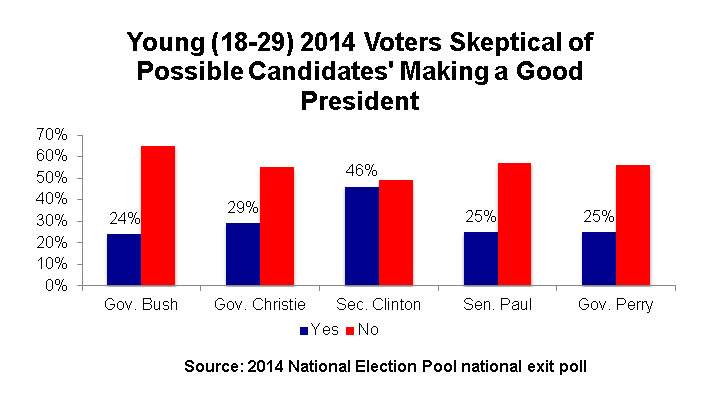Young Voters on 2016 Candidates: Meh
With the recent slew of announcements from prominent candidates, the 2016 presidential race is officially underway. If preliminary data from young voters in 2014 is any indicator, many of those candidates have a long way to go to show young voters they “would make a good president.”
The last time young people voted was 2014, and that election’s exit poll provides insight into likely young voters’ candidate preferences in the next national election.
Among youth (ages 18-29) who voted in 2014, 46% said they thought Secretary Clinton would make a good president, 29% said the same about Governor Christie, 24% about former Gov. Jeb Bush, and 25% about both Senator Paul and Gov. Perry.
Over half of young 2014 voters felt that any of the Republican candidates in the poll would not make a good president. Should that early indicator translate into vote choice in 2016 it would be a departure from long-term trends; historically, Republican presidential candidates have been competitive with Democrats among young voters.
Preferences among 18 to 24-year-olds and 18 to 29-year-olds were not substantially different, though the younger group was not quite as negative about those possible candidates, particularly Gov. Perry: 31% said he would make a good president.
The 2014 exit poll also asked whether voters would be more likely to choose Secretary Clinton or a Republican candidate in 2016. Among youth under 30, 32% said Sec. Clinton, 31% said a Republican candidate, and 35% said “it depends.” On that question, however, 18 to 24-years-old were more likely to say that they would vote for the Republican candidate (36%), compared to 29% for Sec. Clinton, and 34% “it depends”.
What do these numbers mean for 2016? It’s unclear how strong an indicator exit polling from previous elections can be; the 2006 and 2010 polls did not ask about future presidential candidates, so direct comparisons are not possible. The above answers might indicate young people’s familiarity with those names, which can be either an advantage or a drawback. Primary voters will also differ from congressional-election voters in some respects; the electorate will be much larger and there will be new young voters in 2016, as well.
These particular considerations notwithstanding, the data certainly suggests that potential candidates have a lot of work to do in order to gain support for young likely voters in 2016. Look to CIRCLE in the coming months for ongoing analysis of how—if at all—these nascent presidential campaigns reach out to youth, as well as historical data and additional insights related to youth participation in the next presidential election.






